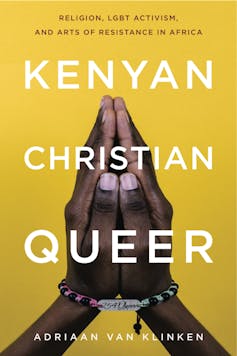By Damaris Seleina Parsitau
The mark of a great book is often its ability to provoke robust debates and force readers to confront uncomfortable content. Kenyan, Christian, Queer by the academic Adriaan Van Klinken provides a way to imagine a future continent where members of the lesbian, gay, bisexual, transgender and intersex (LGBTI) community can exercise their rights to dignity, voice, agency, space and health without fear of stigma, harassment and worse.
The author is a leading voice in LGBTI studies, with a special focus on the role of religion, in particular African Christianity.
In Kenyan, Christian, Queer he presents an ethnographic study of the Kenyan queer community, one that is creating space for its own church and queer theology in a homophobic social, religious and political environment.
Van Klinken wades into a controversial subject to document an array of queer creative practices. In doing so, he advances LGBTI studies. This eloquently written book bravely pushes boundaries. It is remarkable in style and clarity but also brings out the author’s own vulnerabilities, strengths and compassion as an HIV positive gay scholar and activist.
I have known and worked with him for a long time, and this book marks a shift from abstract and academic writing to a creative documentary about the very personal lives of real people. It straddles the gap between academia and LGBTI activism.
The book is also a departure from despair and crippling homophobia. It records the experiences of people who refuse to be hopeless victims: people with hope and urgency, who navigate between resistance and human flourishing, creating more space for community and affirmation. It allows its subjects to tell their own stories.

A thinker, a song, a film and a church
The book examines four cases: activism through art, such as the works of the late Binyavanga Wainaina; music by the gay gospel artist George Barasa; the Stories of Our Lives anthology of short films; and the Cosmopolitan Affirming Church in Nairobi.
In each of these, the author shows how LGBTI actors have reclaimed visibility and engaged Christian beliefs, texts and symbols.
The use of case studies allows for rich and in-depth examinations of the ways in which the LGBTI community in Nairobi is reclaiming social, political, cultural, spiritual and artistic spaces.
Wainaina took on Christian clergy and homophobes, calling them out for their hypocrisy, in particular Pentecostal Christianity. He made this a personal struggle in which he came out as gay and used his body as a site for resistance, vulnerability, acceptance and rejection. His activism gave impetus to the LGBTI community in Kenya and further afield and his death continued to provoke debates about LGBTI issues.
The video of the song Same Love (Remix) by Art Attack caused huge excitement in the Kenyan artistic and social scene. The song is about LGBTI struggles, gender equality and civil liberties. It serves as a beautiful cultural expression of African queer politics – and was promptly banned by Kenya’s Film Control Board. Yet the song serves as a space for political and theological activism. Rap music has long been used as a space for protest and activism. The song crossed social, theological and cultural boundaries and focused attention on the theology of radical and non-normative love.Same Love (Remix) By Art Attack, the LGBTI track banned in Kenya.
Stories of Our Lives by the Nest, a Nairobi-based arts collective, is a collection of personal stories based on interviews with ordinary gay people. Like Same Love, it was promptly banned by the film board, a body that has frequently frustrated Kenya’s creativity in the guise of protecting the nation’s moral fabric. The more the film is banned, the more it is downloaded. It addresses themes such as identity, love, sex, faith and spirituality, stories that capture the diversity of contemporary Kenyan queer lives and their day-to-day experiences.
Personal stories are not just authentic, they are also empowering and affirming. They give voice and impetus to communities in struggle.
The last case study is that of the Cosmopolitan Affirming Church, a social and spiritual space where members of the LGBTI community can practise their faith in community with each other. It is a safe space to create gay and radical theologies; a space for acceptance and love. It is a space where faith and radical love and sexuality meet.
Van Klinken identifies with the struggles of his research subjects but was able to maintain some distance when writing about them.
This is the kind of book I will read again and again as a straight, Christian, female academic and commentator. I will happily share it not just with my students and library but also with those who would like to better understand these contested lives and spaces. Many spiritual leaders need to read it to understand that LGBTI communities are creating their own spaces of worship where they find love and acceptance of their humanity as children of God.
This book evokes many feelings but also forces one to confront one’s own uninformed biases. It’s a good read for those who often shout the loudest, without sufficient understanding of LGBTI lives.




